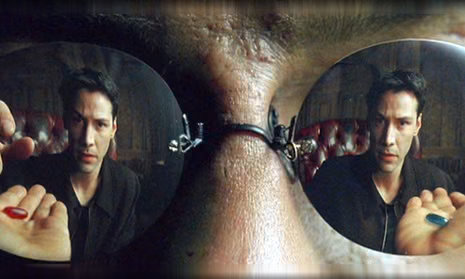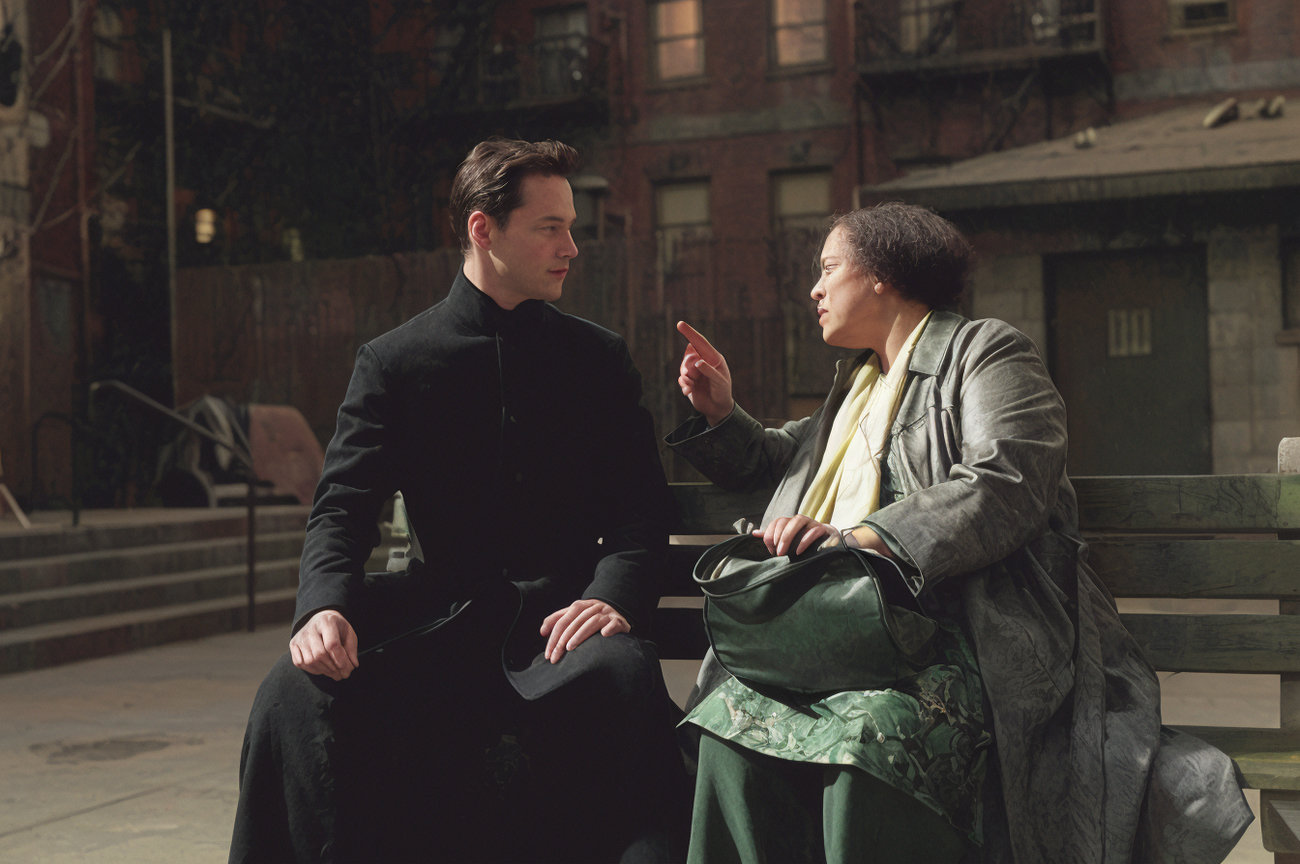Waking Up in the Matrix
These simple words set the stage for Neo's journey and introduce us to the central theme of The Matrix: the quest for authentic existence. At first glance, The Matrix appears to be a science fiction spectacle, laden with gravity-defying action and futuristic dystopia. But beneath its electrifying cyberpunk veneer, the story is a philosophical epic about reality, illusion, and the profound power of choice.
This essay will take you on a journey through the Matrix universe, unraveling its epic symbolism, mythological frameworks, and deconstructions of modern existence. Here, simplicity meets depth, inviting you to contemplate the stirring question at the movie's core: What is real?
Entering the Rabbit Hole: Modern Mythology and Literary Foundations
The iconic message "follow the white rabbit" alludes to Alice in Wonderland, where Alice's journey symbolizes the plunge into unknown worlds. Like Alice, Neo finds himself drawn down a proverbial rabbit hole – leaving behind the familiar and venturing into a domain of possibility and uncertainty. Just as Alice crosses into Wonderland, Neo's encounter with the tattooed "white rabbit" and his subsequent chase set him on his meteorically strange adventure.
The Matrix is rich with literary references that deepen its mythic quality. The room number "101" evokes George Orwell's 1984, signaling interrogation and the suppression of individuality. Neo sells hacking software hidden inside a copy of Simulacra and Simulation by Jean Baudrillard, which introduces the concept that reality itself can be faked and manipulated. When Neo opens the book to the chapter "On Nihilism," the story immediately frames itself as a reflection on the limits of knowledge and the suspicion of all perceived truths.
Choice and Destiny: The Hero's Journey
From the film's opening, Neo is forced to confront choices. The theme reverberates in even minor interactions: Will he follow the strangers to the nightclub? Will he heed Morpheus's cryptic advice? His choices echo Joseph Campbell's "Hero's Journey," as found in The Hero with a Thousand Faces. Neo's invitation to "adventure" marks the beginning of the mythic cycle, where a reluctant hero answers the call and faces trials that ultimately redefine his identity.
Every crucial moment in The Matrix is punctuated by choice. Will Neo accept the terrifying truth Morpheus offers and swallow the red pill, or remain in blissful ignorance by taking the blue one? This dilemma is the movie's heartbeat; every character is confronted with choices that lead to radical transformation or reinforce the status quo.

Layers of Symbolism: Names, Places, and Numbers
Nothing in the Matrix world is accidental. Even the names carry deep significance. The company Neo works for is called "Metacortex." "Meta" means "beyond;" "cortex" refers to the brain's outer layer. Together, "Metacortex" hints at transcending the limits of ordinary consciousness-a fitting metaphor for Neo's awakening.
The motif of numbers, especially "3" and "1," recurs throughout the trilogy. Neo stays at room 101 and later in room 303; Trinity, his closest ally, is also tied to room 303. The ships, gates, and characters frequently appear in triads. These are nods to ancient mystery traditions, Gnostic symbolism, and the sacred geometry of mythic storytelling. Three agents pursue Neo, representing different aspects of the oppressive system. One "chosen" hero emerges from their midst-reminding us of archetypal mythic structures in countless stories, from religious parables to epic sagas.
The Labyrinth: Escaping the Maze of Illusion
When Neo tries to escape from the agents in his office building, he becomes lost in a labyrinth-a reference to Greek mythology's Daedalus and Icarus. The sense of entrapment is palpable; Neo's struggle reflects the human search for meaning amid the confining maze of modern life. Only by listening to the wisdom offered by Morpheus does he begin to break free from these constraints, but not before his own attempt ends in disaster, echoing Icarus's fall.
Philosophical Underpinnings: Reality, Truth, and Simulation
"What is real?" This question, posed by Morpheus, is the philosophical nucleus of The Matrix. Morpheus's teaching closely follows Baudrillard's concept of simulated reality, suggesting that our experiences may themselves be artificial constructs. The film's readiness to ask whether anything is objectively real is a direct challenge to viewers and a tribute to philosophical thought stretching back to Plato's Allegory of the Cave.
"Temet Nosce"-"Know yourself"-etched in the Oracle's kitchen is yet another layer of philosophical wisdom. The phrase is an ancient call to introspection, from Plato's works and inscribed above the fabled temple of Delphi. The Oracle herself represents both prophecy and self-discovery, paralleling Socrates. Just as Socrates questioned everything and claimed to know only his own ignorance, Neo must embark on his own journey of inner discovery.

The Matrix as Collective Dream
The film often references dreams, hallucinations, and altered states. Neo's customers, "Choi" and "Dujour," are named for choice and day, suggesting the constant passage and necessity of decision. Their discussion of "mescaline" (a hallucinogenic drug) and the confusion between dream and wakefulness speak to the film's theme of reality as a shared, possibly illusory, hallucination. This narrative references Aldous Huxley's The Doors of Perception, which explores consciousness and altered states.
Jorge Luis Borges's "Ficciones" is invoked when Morpheus discusses dreams: the story of a man dreaming he is a butterfly, only to question if he is a man dreaming he is a butterfly, or a butterfly dreaming he is a man. The Matrix offers this paradox as its haunting suggestion-humans may merely be trapped inside shared dreams, never able to distinguish what is truly real.
The Oracle and Socratic Wisdom
The Oracle's wisdom aligns her with ancient figures of insight and prophecy. She not only predicts, but understands people before they act-a trait attributed to Socrates, who mastered the art of examining others' true intentions. The film fuses elements of Greek philosophy and modern science fiction, reminding us that the oldest questions about self-knowledge remain essential even in futuristic settings.
Agent Smith and the Nature of Humanity
Agent Smith, the film's primary antagonist, delivers some of the Matrix's most chilling philosophical arguments. He bluntly rejects Darwinian theory, insisting that humanity is not a mammal in harmony with nature but a virus, a plague upon the earth. Smith's speeches explore humanity's self-destructive tendencies, raising questions about whether progress and technology ultimately distance us from authentic living.
Smith's view is ultimately nihilistic-a belief that nothing has inherent meaning. This stark vision of humanity paints a world in which knowledge, order, and even survival may be illusions, held together only by the "codes" that sustain the Matrix.

Fairy Tales and the Search for Home
The film subverts fairy-tale expectations with witty lines and references: Dorothy's wish to return home in The Wizard of Oz mirrors Neo's desire to escape the artificial world of the Matrix. His request to "Mr. Wizard" to be rescued is a poignant reminder that every hero's journey includes the longing for comfort and belonging, even when the real world is harsh and unfamiliar.
Science and Skepticism: Karl Popper in the Matrix
The Matrix draws not only from myth and philosophy but also from the world of scientific skepticism. The "Kid" character in the Animatrix is modeled on philosopher Karl Popper, who asserted that science is about falsification rather than verification-a theory is only scientific if it can be disproven. The act of "unplugging" oneself from the Matrix becomes a metaphor for skepticism and free thought, testing the foundations of perceived reality.
The Kid's leap from a building (expecting death, but instead waking in the real world) is a radical act of hypothesis testing. The lesson: Only those who question, risk, and act can awaken to new realities.
Martial Arts, Mastery, and Self-Realization
One of the most beloved aspects of the Matrix trilogy is its dazzling portrayal of martial arts. When Neo fights Seraph, he doesn't land a single blow-until a shift in confidence changes the tide. Seraph's test is not just physical, but philosophical: he wants to know who Neo truly is. This reflects the tradition, especially in Eastern martial arts and philosophy, where combat is ultimately about self-knowledge.
"Know yourself," Seraph implies. The journey of the hero is internal as much as external.
Empiricism vs. Gnosticism: Locke and Morpheus
The dynamic between Commander Locke and Morpheus in Matrix Revolutions is another philosophical riff. Locke is based on John Locke, 17th-century philosopher and defender of empiricism-the idea that knowledge comes from experience. Morpheus, a Gnostic, places faith in intuition, prophecy, and hope. Their clash is the battle between realism and idealism, military logic and spiritual belief.
Visual Codes and the Glitch in Reality
Even the visual language of the Matrix repays close attention. Raindrops during Neo's battle with Smith transform into lines of code, signaling the crumbling of barriers between virtual and real worlds. The film's details, visible even under close inspection, are reminders that nothing in the Matrix is random-each glitch, line, and color shift reinforces the collapse of artificial systems upon authentic experience.
Repetition and Renewal: The Cycle of the Matrix
Toward the trilogy's end, the Matrix "reboots," beginning its seventh iteration. The artificial peace signals with the shift from red lights to green, marking another cycle. The story ultimately closes with a memorial to Thomas Anderson (Neo), signifying the lasting importance of questioning, striving, and seeking truth.
Simplicity and Depth: The Lasting Impact of the Matrix
The Matrix's genius lies in its ability to present complex themes in simple, compelling ways. It is more than a movie-it is an invitation to philosophical reflection, a challenge to awaken autonomy, and a hymn to the heroic spirit in every individual. The motifs of choice, awakening, and self-knowledge anchor its narrative, embedding timeless questions within pulse-pounding adventure.
Everyone is a potential Neo-living through the haze of constructed realities, only to be called to "wake up" and search for the truth beneath the surface. The journey through the labyrinth, the confrontation with doubt, and the triumph over illusion remind us that reality is not only what we perceive, but what we choose to make real.
You Are the One
The legend of the Matrix lives on because it speaks to basic, universal human concerns. It challenges audiences to think, to choose, and to act-to live not as passive subjects of a coded reality, but as active creators of genuine experience. The Odyssey of Neo is every viewer's journey: from ignorance to knowledge, doubt to faith, simulation to the possibility of true awakening.
The red pill awaits those willing to question. The labyrinth can be escaped by those who persist. And every choice, made in the face of uncertainty, is an epic in itself.
Welcome to the desert of truth. Wake up.